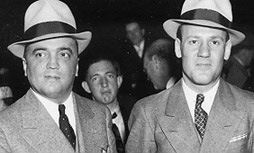“Earlier versions of Superman stressed the hero’s humanity: his attachment to his Earth parents, his country-boy clumsiness around Lois,” writes Time‘s Richard Corliss. But Bryan Singer’s Superman Returns “emphasizes his divinity. He is not a super man; he is a god (named Kal-El), sent by his heavenly father (Jor-El) to protect Earth. That is a mission that takes more than muscles ; it requires sacrifice, perhaps of his own life. So he is no simple comic-book hunk. He is Earth’s savior: Jesus Christ Superman .”
Love Lies Bleeding
Romantic movies with happy blue-sky endings don’t resonate. The ones that sink into people’s souls are about love lost at such a cost. That’s the enduring thing, the special alchemy. If, say, J. Edgar Hoover and Clyde Tolson had been forced apart by fate, you’d have a movie. But they were close and pretty much inseparable their entire lives…flatline.

You’d think that somewhere in Borys Kit‘s Hollywood Reporter story somebody would have mentioned this, and perhaps commented on what I suspect is a reluctance to buy into the sad-is-better idea on the part of producers and female moviegoers. Everybody wants love and happiness and white-picket fences, but movies that grab you and pay off are never finally about characters fulfilled.
Evolving Formats
The Spokesman-Review‘s Frank Sennett writes about formerly print-influenced news and opinion sites — this one included — morphing into blog streams.
IMAX Superman
See it in IMAX…that’s the all of it. The last feature shown in IMAX that really played with legs was Robert Zemeckis and Tom Hanks’ The Polar Express.
Seattle snafu
As things stand now (at 8:58 am), my luggage is in Los Angeles and I’m still in Seattle, at a Days Inn near the airport. I missed my flight back to LA last night, and it was definitely Alaska Airline’s fault. When I got to the check-in counter around 6:55 pm both the check-in computer and the Alaska Airlines rep said the flight would be delayed until 9:30 pm, and that boarding would happen around 9 pm. No prob…I went to the gate area, hooked up my computer in a cafe and did some work. Two hours later I went over to the departure gate at 9 pm…empty. Checked with an Alaska rep — “Oh, that flight left at 8:40 pm.” They have me on a flight leaving this morning at 11:30.
Denby vs, Guantanamo
New Yorker critic David Denby on some of the curious and/or incomplete aspects of The Road to Guantanamo.
Iraq puppies
Deborah Scranton‘s The War Tapes (SenArt) is an Iraq War documentary composed of footage shot by National Guard guys doing their service. Here’s a description of a “deft little turn” in the film in David Carr‘s 6.19 N.Y. Times column, to wit: “Specialist Mike Moriarty is filming his squad leader, Staff Sgt. Kevin Shangraw, as they bounce along in a Humvee. He asks his leader for his take on the broader mission, and Sergeant Shangraw comes straight off the dome with a government-issue rationale. ‘Well, I think it’s a fantastic opportunity for the Iraqis to establish a new history in the country and be able to be a free and democratic society, which in turn should stabilize the whole Middle East and create a freer and more stable earth as we know it.’ Then Moriarty, unseen, asks, ‘Tell me how you really feel.’ Shangraw waits a beat as the bleak landscape flies by in the window before answering. ‘Then, after that happens, maybe we can buy everybody in the world a puppy.'”
Break-Up Boner
Variety‘s Peter Bart on how the tea-leaf readers misunderstood the fate of The Break-Up.
Three by Nilsson
In honor (once again) of John Scheinfeld‘s Who is Harry Nilsson (And Why Is Everybody Talkin’ About Him)?, which just played to enthused auds at the Seattle Film but has been snubbed by the L.A. Film Festival for some curious reason, three of Harry’s songs — “You’re Breakin’ My Heart“, “Maybe” and “Gotta Get Up“.
Klaus Kent
For those of you who never saw that 1978 “Saturday Night Live” skit that asked what might have happened if Superman/Clark Kent’s Krypton meteor had landed in a village in Germany in the 1930s instead of the Kent farm in Smallville…here‘s a transcript. The idea was that Superman’s gullibly nationalistic philosophy (i.e., equating “truth” and “justice” with “the American way”) would have conformed to the realities of Nazi Germany, and he therefore would have been Uberman/Klaus Kent, and he would have been able to easily identify Jews-in-hiding with his x-ray vision, etc. I wonder if this bit is viewable on one of those SNL DVDs? I’m assuming it is.
“Sin” Wins
It was that silver nitrate black-and-white noir thing…right? The Hollywood Reporter’s 35th annual Key Art Awards ceremony last Friday night gave Dimension Films’ Sin City four trophies — for best action adventure trailer, best teaser trailer, best home entertainment-consumer audiovisual, and some kind of special recognition for “character banners designed for the film”…whatever that means.
McCarthy reviews “Superman Returns”
“‘Why the World Doesn’t Need Superman’ reads the title of a piece that wins Lois Lane the Pulitzer Prize in Superman Returns, the latest bigscreen revival of comicdom’s strongest and fastest hero. Not only is she wrong in the context of the story (not to mention real life), but she’ll be wrong in the court of public opinion once the world gets a look at this most grandly conceived and sensitively drawn Superman saga. Sure to rate with aficionados alongside Spider-Man 2 and, for many, Batman Begins on the short list of best superhero spectaculars, pic more than justifies director Bryan Singer’s decision to jump ship from the X-Men franchise, and will pull down stratospheric B.O. around the globe.” — from Todd McCarthy‘s review in Variety. (The Hollywood Reporter‘s Kirk Honeycutt likes it also.)

